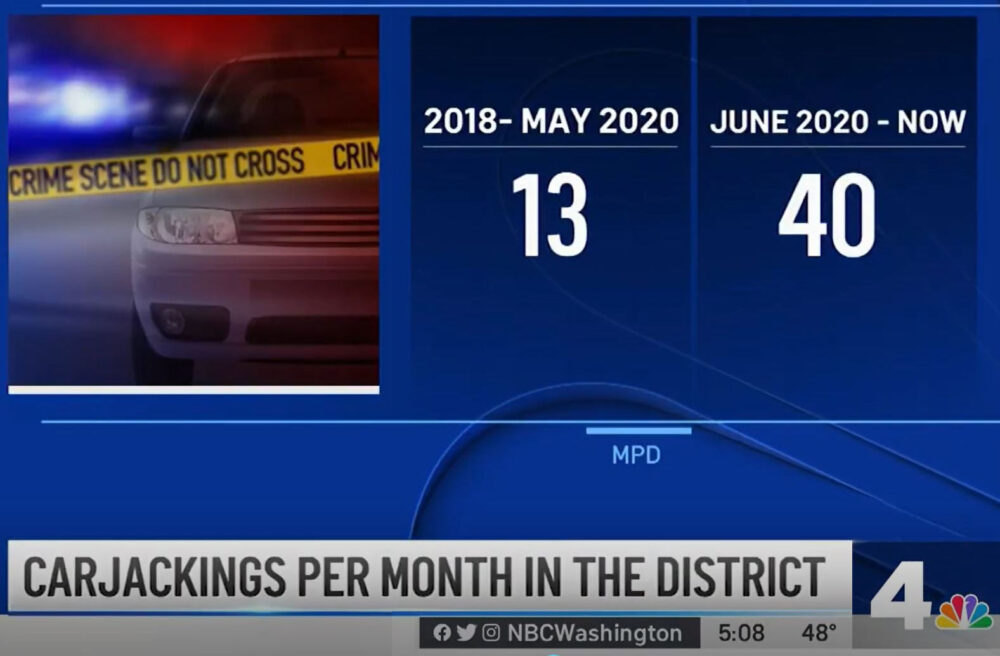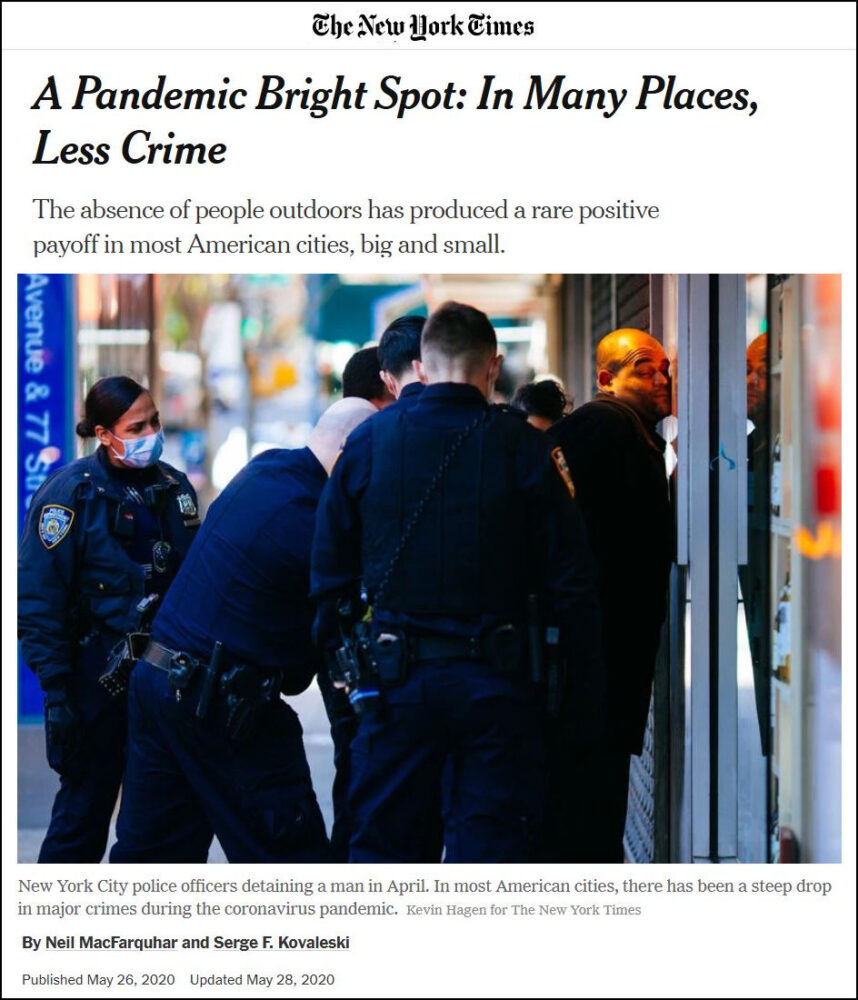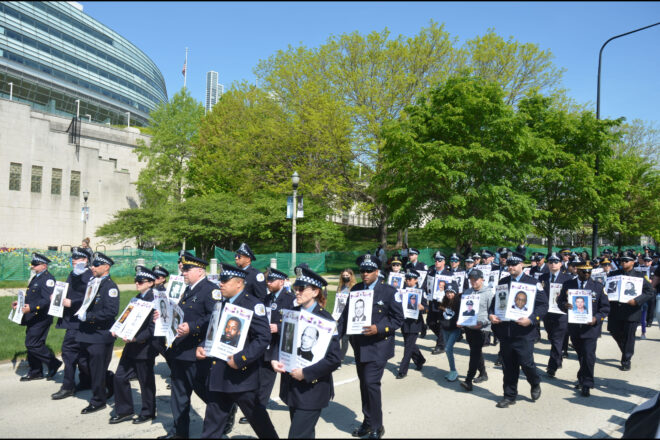The news cycle last week was dominated by coverage relating to the death of Tyre Nichols. Nichols died three days after he was stopped by, fled from, and was stopped again by police in Memphis on 7 January 2023. An extended struggle with police left Nichols severely injured. Two fire department EMTs and a fire lieutenant have been terminated for not providing adequate medical attention. Police body camera and other video footage of these interactions were released last Friday. Condemnation surrounding the actions of five Memphis police officers involved in that incident has been swift and widespread. Those officers were quickly terminated and now face criminal charges. But, a lesser news item from last week should not be ignored. Police in Washington, DC repeated the pandemic excuse for continuing carjacking issues in that city. The lesser incident highlights a larger and related problem relative to public safety.
Estimated reading time: 15 minutes
What is the Larger Problem?
The community is right to seek both public safety and constitutional policing. As a community we must work not be misled, even when tragedies occur. Being misled, often deliberately so, is an increasing problem. This is particularly true when the issues at hand impact the crime, public safety, and justice discussion. The news media generally, and social media nearly without exception, are not forums for understanding complex topics. How much can truly be explained in a 30-second news read or a 280-character tweet? Not much. Yet, this is the extent of the analysis offered to most people. Well, other than their personal experiences and fears of being victimized.
A Model to Provide Some Clarity
Damaged police-community relationships and broad-brush efforts seeking to demonize the police are among the biggest issues that come with severe public safety consequences.
For policing, their public safety mission is built from a foundation of adherence to the principles of the United States Constitution. It recognizes the vital nature of community support, and seeks only realistic expectations for our police officers. It understands the importance of hiring the best, most committed individuals as police officers. So too, it understands that their commitment is to the people, which they signify by swearing an oath to the constitution.
Portrayed using a jenga-like puzzle, the model emphasizes several additional points. Remove key blocks, and the entire structure necessary for public safety is vulnerable. Law enforcement recruitment standards and staffing must attract the best. Training for the police is key. But, so too for elected officials, the court system and the community. There must be respect for those doing the work, and respect from our officers for the community. The demands of leadership must be met and permeate throughout all public safety efforts. Supervisory excellence within police agencies is crucial. There must be a functioning court system that protects victims and holds offenders accountable. There must also be respect for the truth. The pursuit and response to the demands of truth are essential. A truth that rejects deception excuses. Finally, the model also recognizes that there maybe other blocks that we may need to identify and understand better.
Again with THE Pandemic Excuse
We have previously called attention to the distraction approach in glossing over an uncomfortable crime reality. In the midst of purported reforms, public safety in America has worsened. Among the deceptions, “THE pandemic” did it. The pandemic was a convenient coverall for many failed public policy approaches. It is truly amazing that THE pandemic excuse is still being trotted out in January 2023 relative to public safety.
To be fair, carjackings are not just an increasing problem in the nation’s capital. Carjackings have been among the most visible offenses of the lawlessness spike since the end of May 2020. Only the rise in shootings and murders have caused more fear in America’s cities. Only unchecked and mass shoplifting incidents have generated more video evidence of an increasingly meaningless court system. To be fair again, last year, officials in other cities also pulled THE pandemic excuse. And, it is not only in DC that there has been an explosion of juvenile offenders involved in carjackings. Why? Because, the abandonment of the justice system in holding offenders accountable has been the most visible relative to juvenile crime. We have seen that clearly in Chicago. Carjacking is not only a difficult crime to prove, juveniles are rarely detained any length of time for these crimes when they are apprehended.
In DC the Pandemic Still Causing Carjackings – Not
I do not know the police sergeant from DC who participated in the news story on this topic from NBC Washington last week. She appears dedicated, perhaps even participating in the interview while off-duty. She is knowledgeable and it seems she is actively working to address these crimes. As indicated in the report, carjackings have spiked in DC, and there is a problem with repeat juvenile offenders committing these offenses. According to the report, “the spike in carjackings appears to be linked to the start of the pandemic.” A portion of an interview with the police sergeant was used to support that narrative.

From 2018 through May 2020, Washington, DC experienced on average 13 carjackings per month. From June 2020 through January 2023, that city has averaged 40 carjackings per month.
A Deception
THE Pandemic excuse never had an ounce of validity. Again, COVID-19 does not cause reckless driving, theft, carjackings, robberies and violence. Only when the failed pandemic response policies are silently switched as the cause is there any validity. Those policies pushed extended lockdowns, closed schools (for a year or more in many cities), crushed small businesses and crashed the economy, creating desperation and panic among large segments of the population. Those policy responses did weaken the social structure on which public safety rests. But, even that truth is a sleight-of-hand relative to the explosion of lawlessness that can be traced back to the end of May of 2020.
Calling out the excuse is important, as it fails to identify the true causes for the crime spike. As a community we are not likely to fix what we will not even properly analyze.
Before THE Pandemic Did It – It Did the Opposite
Let us not forget that in the beginning of May 2020, the media was talking about the crime reduction benefit of THE pandemic. That fact has largely been memory holed.
The New York Times (NYT) first ran a story entitled, “A Pandemic Bright Spot: In Many Places Less Crime,” on 26 May 2020. The NYT had been working on that story for a couple weeks. Doing their part to support the lockdowns and other COVID response policies. That story was picked up by newswires and media across the country. Other news outlets did similar stories. Well, that was until the next weekend when unrest and violence erupted in cities across the nation.
What happened? Well the NYT article (and others like it) ran on Tuesday, 26 May 2020. While George Floyd had been arrested and died in police custody the day before. 25 May 2020 was a Monday. Despite widespread condemnation of former Police Officer Derek Chauvin, even among other officers and police officials, that next Friday the wheels came off. That is what happened. Police-community relations were set ablaze thousands of miles away from Minneapolis, and in most urban areas in between.
A Lesson From 2020
Using our graphic, the community support block was quickly pulled out. Other key blocks were impacted as well. Such well served the interests of those seeking to demonize the entire policing profession, as a means of advancing otherwise unpopular political objectives. Public safety was sacrificed in the process, and the national murder rate rose nearly 30% in 2020 as a result.
The truth, a key block in our model, such encounters are far from the norm of what policing in America looks like. That truth was largely ignored for many months. It was only this past November that the US Department of Justice came out with an extensive analysis of police-citizen encounters during 2020. What did that data show? It showed what actual analysis consistently shows. Nearly 54 million Americans had contact with the police in 2020. In only about 1% of those contacts did the person interacting with the police allege they experienced police misconduct.
Tragic incidents like the one in Minneapolis in May 2020 are beyond rare. So too is the incident last week in Memphis. Yes, never would be best. But, the reality is that we have courts for a reason. Since Cain killed Abel, there has been a need. We are all in need of salvation. When that day comes, we will no longer have a need for the police to maintain public safety. That day has not yet arrived, and we must therefore hold firm to our peacemakers.
Tragedy-Free Policing, Or Else
I coined this term and first described its impact in the article, Tragedy-Free Policing or Else: The Need for Critical Thinking. “Tragedy-free policing” is a dangerous worldview that holds the police should never take any actions that could cause harm, their actions should never use any force, and the police must act without ever making a mistake. Acceptance of this false standard places the police-community relationship essential for public safety at risk. Why? Because in reality, the police are regularly thrust into circumstances that are already tragic or at grave risk of quickly turning tragic.
Worse, in the wake of tragedy, the most devisive elements in 2020 successfully leveraged legitimate communty concerns about constitutional policing. In doing so, they advanced an “or else” to the standard. The “or else” holds wrongly that whenever the police are involved in an incident that has a tragic outcome, then rage, violent protests, and looting are justified. We saw “or else” play out across the country in 2020. Such is a risk even when there is no misconduct on the part of the involved officer.
Additionally, “or else” resulted in legislative and policy changes that deliberately sought to “reign in” the police and dramatically scale back the justice system. The aftereffect remains, as crime and violence levels remain significantly higher than they were in 2019.
A Not “Tragedy-Free” Stop in Memphis
Among those critical of the police stop of Tyre Nichols in Memphis was Cerelyn “CJ” Davis, Chief of the Memphis Police Department (MPD). Chief Davis terminated five MPD officers from the second stop on 20 January 2023 for excessive force and related policy violations. On 26 January 2023, Shelby County (TN) District Attorney Steve Mulroy announced the five officers had been indicted on Second Degree Murder and other charges. The five charged officers were: Tadarrius Bean, Demetrius Haley, Emmitt Martin III, Desmond Mills, Jr., and Justin Smith.
In an official video, Chief Davis described the incident as “not just a professional failing,” but also as “a failing of basic humanity toward another individual.” In the video and media interviews she further described the incident as “heinous, reckless, and inhumane.”
In reality, we are still early into the accountability process. Social media is rife with speculation about the incident, potential consequences for the entire policing profession, and the backgrounds of the involved officers. More will be learned in the months ahead. As the criminal process plays out, as a nation, we should take note of the analysis from Rafael A. Mangual. “The deplorable actions depicted in the videos released by the city of Memphis are not representative of policing as an institution.” We will also be wise to remember the building blocks for the police to meet their public safety.
SCORPION
As reported by Reuters News Service, the now-former officers ranged in age from 24 to 32. While all five were assigned to a special citywide anti-violence, none of the officers had more than five years of service with MPD, and two are known to have worked for MPD for only about two and a half years. The unit, known by the acronym SCORPION, was created in November 2021 by Chief Davis as a response to rising violence. The acronym, which is now spurring additional controversy, stood for Street Crimes Operation to Restore Peace in Our Neighborhoods.
ABC News reported: “Two months into SCORPION’s deployment, Memphis Mayor Jim Strickland touted the unit’s effectiveness. In his state of the city speech, Strickland claimed the unit was responsible for 566 arrests, 390 of them felony arrests, seized $103,000 in cash, 270 vehicles and 253 weapons between October 2021 and Jan. 23, 2022.”
Specialized Units
The truth is that such specialized units have for decades shown the ability to reduce violence in cities across the country. The truth is also that officer experience, proper temperament, and effective supervision are also key. Absent those factors, there are increased risks for misconduct and damaged police-community relations. Based upon the post-incident reporting, MPD leadership apparently fell short in monitoring the unit. Chief Davis initially resisted disbanding the entire unit based on the actions of the five charged officers. However, continued pressure on the mayor and chief led to the unit’s disbanding on 28 January 2023.
Nothing about the Memphis incident is good news. A man died. His family has been left devastated. Life altering consequences will impact many others, including the families of the accused officers. Moreover, the Memphis community must seek to guard against the wider consequences that come when the “Tragedy-Free Policing, or Else” standard takes root. Our experience from 2020 provides a stark warning. Additional reason for concern comes from other cities that have quickly disbanded key anti-violence units following scandal or controversy. After shutting down such units, violence in those communities typically worsens. Sadly, the indicators are that since last week public safety in Memphis is now at greater risk.
The Problem of the Wrong Solutions
In the wake of tragedy, a sad and dangerous combination often occurs. As Americans process a tragic public safety incident, they are given “THE pandemic” and similar deceptions. Far too often, politicians and the media respond to the urgings of “something must be done” claiming new laws are the panacea. What is most peculiar about this approach, and at times even completely dishonest, is the simultaneous lack of respect for the rule of law among many of the most vocal proponents. Policies that discourage, even prohibit, enforcement efforts are heralded. We are told to ignore the dismantling of the processes that hold the actual offenders accountable. We are encouraged to embrace non-prosecuting prosecutors. In this new age, we are supposed to believe we can simply wish lawlessness and violence away.
Conversely, a news item that will not garner 1/100th of the media coverage of the incident in Memphis occurred Tuesday in Fresno, CA. The ambush murder of Police Officer Gonzalo Carrasco, Jr. His attacker was a convicted felon and gang member, who had been released early from prison, and was already in violation of his probation conditions. Such incidents do not fit the “tragedy-free policing or else“ narrative. Why? Because the life taken was that of a police officer, and it was taken by an offender sent too quickly back to the streets of an American city. THE pandemic was not a factor in this crime. Such cannot be said for the rise of misdirected reform approaches and California’s weakened justice system.
The Way Forward
I agree with policing expert Travis Yates. Courageous leadership will be one of the keys if we are to enhance public safety. Yates, in a posting Tuesday, reminded us: “courageous leaders do everything they can to build great police departments regardless of some high profile event or national outrage.”
As a profession, it is essential that our police departments pursue the heights of excellence. Police executives must fully understand the Eight Levels of Supervisory Engagement, and truly foster active supervisory excellence. They must distinguish between error (even tragedy) and true misconduct, and seek to advance Five Pillars in the Handling Police Misconduct Investigations: Truth, Fairness, Respect, Improvement, and Proportionality. Police executives must also embrace the Six Pillars of Police Policy, consisting of Clarity, Courage, Consistency, Confidence, Consensus and Capacity. Just as importantly, each officer must understand that in policing All-Levels Leadership is required. Key to this understanding is a reminder of the oath to the constitution that every law enforcement member must swear. Each officer takes and holds the responsibility of that oath as an individual. I stand ready to bring such training to any law enforcement agency in need.
The Responsibility of the Community of Us
As we move forward, we must fully embrace the realities of how policing meets its public safety mission. It begins with a firm adherence to the constitution and the strength of the police-community relationship. It also relies upon recruitment, commitment, training, supervision, leadership, a properly functioning court system, and an embrace of the demands of respect and truth. They are all key building blocks to enhancing public safety.
The way forward must be one with broad outreach across community partners. In the words of Sir Robert Peel, “the police are the public and the public are the police.” The responsibility for public safety and a just society rests with all of us. In building safer and stronger communities, we must reject all deception excuses intended to explain away lawlessness. As a community, we need our elected and civic leaders to foster unifying approaches that advance constitutional policing, reduce violence, address chronic crime conditions, improve public safety, protect victims, foster wellness, and enhance community support for the police. Those seeking and participating in police reform efforts must not lose sight of these core elements.
As a profession, it is essential that those working in law enforcement fully reawaken their community policing roots, and engage in active problem-solving directly with all community residents and stakeholders. Policing must honestly seek to reach the hearts and minds of the community and call them to action. If policing is to regain the support necessary for them to meet their public safety mission – the voices of support for the police must be heard from across the “community of us.”
We are interested in your thoughts, and invite you to comment below.





The pandemic has been a convenient excuse for politicians to explain the failures of their radical policies. The woke, liberal laws passed in many blue states have emboldened criminals and handcuffed the police. It’s not the pandemic that created lawlessness. It’s the politicians.